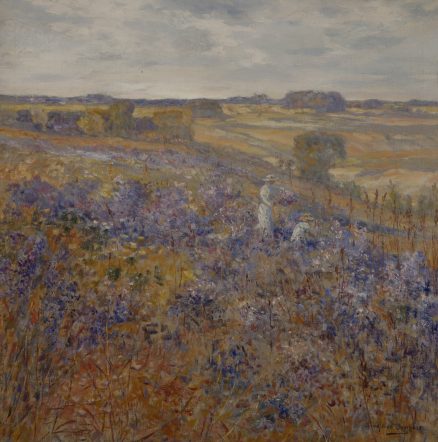- Categories
- Landscapes
- Zoom in on Artwork
- Print Page
- Email Page to Friend
With its square format and high horizon, Alfred Juergens’s New England Asters envelopes the viewer in an expansive late-summer landscape suffused with gold and purple tones. A gently sloping hillside gives way to a vista of open fields and clumps of trees under a high canopy of clouds. The tall grasses and wildflowers spread across the foreground are described in spots and dashes of color; in their midst, two women in summer whites gather blossoms from the abundance that surrounds them. In the bright but diffused light that saturates the scene, these figures cast shadows that echo the purple of the flowers. They lend a sense of scale to the image and orient it to vacation-time leisure rather than agrarian labor.
After the turn of the twentieth century, Juergens’s output shifted from dark-toned figural images of European village life to impressionist landscape images in which figures are mere accessories. He became renowned for garden and floral images, many painted in his own neighborhood in the Chicago suburb of Oak Park, Illinois. Juergens also painted landscapes throughout the Chicago region and in southwestern Michigan, especially around Grand Rapids, possibly the setting shown here. The artist exhibited Michigan landscapes as early as 1909. He rarely dated his paintings, but this one reflects the fashions of the early 1910s, notably the relatively straight lines of the standing woman’s skirt and her straight sleeves, along with both figures’ wide-brimmed hats.
New England Asters combines a bucolic setting with Juergens’s interest in floral subjects. The flowers dominate the composition, as suggested by the title the artist inscribed on a label on the back of the painting. Notwithstanding its name, the New England aster grows wild throughout the upper Midwest, including Michigan. Here, however, the rapidly applied brushstrokes communicate not the specific appearance of the flowers but rather a generalized impression of rich texture and brilliant color. Reviewing one of several memorial exhibitions for Juergens in 1938, Chicago Tribune critic Eleanor Jewett might have been referring to New England Asters when she wrote that “A hillside of flowering weeds turns into a paradise under his brush.”i
Wendy Greenhouse, PhD
i Eleanor Jewett, “Give Juergens High Place in American Art,” Chicago Tribune, June 10, 1938.
